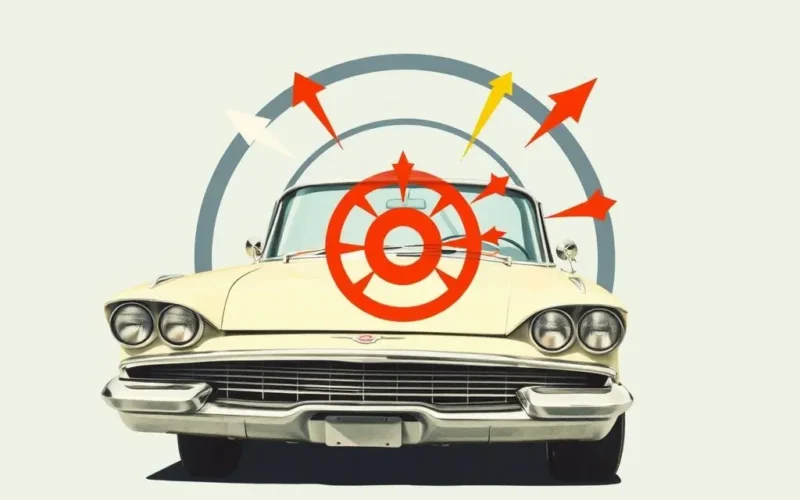Remember the Edsel? For most, the answer is probably a resounding ‘not really’. And oddly enough, that lack of recognition is precisely the point.
This isn’t merely the story of a failed car; it’s a compelling, high-octane lesson in how *not* to bring an ambitious innovation to the market. Think of it as a masterclass taught in the school of hard knocks, costing Ford Motor Company millions of dollars.
Ford poured vast sums into the Edsel project, building it up with a level of hype rarely seen before, promising a vehicle that would redefine the automotive landscape. It was billed as the future on four wheels, a perfect harmony of cutting-edge style and revolutionary technology.
Yet, when the rubber finally hit the road, the reality was starkly different. The technology, hyped as groundbreaking, felt clunky and unreliable. The design was… well, let’s just say it generated strong opinions, often negative ones. And perhaps most critically, the market had already shifted gears, leaving the Edsel feeling like yesterday’s news before it even truly arrived.
It stands as a stark, chrome-plated reminder that brilliant engineering and lavish spending mean almost nothing if you don’t genuinely understand who you’re building for, what they actually want, and when the right moment is to make your move.
Before we delve deeper into this epic misstep, take a moment to watch this short video summary that perfectly encapsulates the Edsel’s unfortunate fate:
As that little clip suggests, the Edsel debacle powerfully illustrates the critical importance of listening intently to potential customers, striving for true, user-centered innovation, and avoiding the trap of simply *assuming* you possess all the answers. It echoes that timeless adage: "Innovation without adoption is just invention."
So, let’s park ourselves here for a moment and dissect exactly what went wrong with Ford’s ill-fated Edsel, and what enduring lessons it offers innovators, marketers, and anyone daring to create something new today.
The Genesis: Born in the Boom, Destined for Trouble?
The Edsel was conceived in the mid-1950s, a time of unprecedented prosperity in America. The post-war boom was in full swing, disposable income was rising, and families were eager to trade up their cars. Ford, like its rivals General Motors and Chrysler, wanted to capitalize on this burgeoning market, specifically targeting the gap between their entry-level Ford models and the more upscale Mercury line. The idea was to create a new division, a new brand entirely, positioned squarely in the upper-medium price range – a direct competitor to GM’s Oldsmobile, Buick, and Chrysler’s DeSoto.
The project was shrouded in secrecy during its development, code-named the "E car". Ford undertook extensive market research, surveys, and focus groups to determine what this new car should be and what it should be called. Ironically, some of this research actually hinted at potential problems, but these signals were largely overlooked or misinterpreted by the ambitious executives steering the project.
Ford envisioned a car that would be distinctly different, instantly recognizable, and packed with novel features. They wanted to make a splash, and they allocated a staggering amount of resources – estimates range widely, but figures often cited are between $250 million and $350 million (that’s billions in today’s money) – into development, tooling, and a massive marketing campaign.
The Ambition: Promised Technology and Unique Style
The Edsel wasn’t just supposed to look different; it was engineered to offer features that were genuinely innovative for its time. The most talked-about, and ultimately problematic, piece of technology was the Teletouch Drive. This was a pushbutton transmission control system mounted on the steering wheel hub, designed for supposed convenience and futuristic appeal. Instead of a lever on the column or floor, you’d press buttons labelled P, R, N, D, L.
Other notable, though less revolutionary, features included a rolling-dome speedometer, self-adjusting brakes, and interlocks for things like the parking brake and ignition.
From a design perspective, the goal was unmistakable identity. Ford wanted the Edsel to stand out in a crowded field. This led to the controversial vertical grille, often likened uncharitably to a horse collar or worse. The overall styling aimed for modernism and distinctiveness, but the execution, particularly the front fascia, proved divisive from the moment it was revealed.
The Reality: Where the Wheels Fell Off
Despite the enormous investment and grand ambitions, almost everything that could go wrong with the Edsel launch, did.
Marketing That Missed the Mark
The "E car" project generated immense pre-launch hype. Ford built anticipation to a fever pitch, but without clearly defining what the car *was* or *who* it was for. When the Edsel finally debuted on "E Day", September 4, 1957, the public found a car that struggled to live up to the inflated expectations. The marketing created confusion: was it luxury? Sporty? Practical? It felt like a solution looking for a problem, or perhaps worse, a collection of ideas without a cohesive identity.
Furthermore, the extensive market research, while conducted, seems to have been misinterpreted or ignored when it came to critical aspects like naming (many of the proposed names, including Edsel, tested poorly) and design preferences.

Technology That Was Clunky, Not Cutting-Edge
The much-lauded Teletouch transmission system, while innovative in concept, suffered from reliability issues almost immediately. It was prone to failure, difficult to repair, and often felt less intuitive than a traditional lever. In an era where consumers valued simplicity and reliability, a finicky, expensive-to-fix gadget was a significant deterrent. Other features also had their quirks, contributing to a perception of poor build quality.

Design That Repelled More Than It Attracted
Beauty is subjective, but the Edsel’s styling, particularly its front grille, became the object of widespread ridicule and disdain. It was instantly polarizing, failing to achieve the broad appeal necessary for a mass-market car. While some appreciated its distinctiveness, many more found it awkward or ugly. This immediate negative reaction to its appearance severely hampered its chances from day one.

Terrible Timing
Adding insult to injury, the Edsel launched just as the U.S. entered a significant economic recession in late 1957. The target demographic, the upwardly mobile middle class, suddenly became more cautious with their spending. A brand-new, distinctively styled, and somewhat expensive car was exactly the kind of discretionary purchase people cut back on. The market for mid-range cars shrunk, and the Edsel was squeezed between cheaper Fords and slightly more expensive Mercurys, with no clear value proposition.
Internal Competition
Within Ford dealerships, the Edsel often found itself competing directly for showroom space and sales attention with Mercury, and sometimes even higher-end Fords, further muddying its brand identity and cannibalizing potential sales.
The Aftermath: A Costly Lesson
The sales figures were dismal. Ford had projected selling hundreds of thousands of Edsels in the first year; they sold barely 63,000. Sales continued to plummet in 1959 and 1960. By late 1959, it was clear the project was unsustainable. Ford ceased production of the Edsel in November 1959, after less than three model years.
The financial loss for Ford was immense, estimated to be between $250 million and $350 million, a figure that made the Edsel synonymous with spectacular business failure for decades.

The Edsel’s Enduring Whisper: Lessons for Today’s Innovators
While the Edsel rolled off the assembly line over 60 years ago, its story remains remarkably relevant in the fast-paced world of technology and product development. It serves as a potent case study for anyone planning a new product launch, whether it’s a car, a smartphone, a software application, or a new service.
Key Takeaways:
- Know Your Audience (Really Know Them): Ford *thought* they knew what the market wanted, but they failed to connect with consumers’ actual desires and tastes at that specific moment. Listen to feedback, understand pain points, and validate your assumptions rigorously.
- Hype Without Substance Backfires: Building immense anticipation for a product that doesn’t deliver on its promises leads to rapid disillusionment and damages brand credibility.
- Timing is Everything: Launching an expensive, non-essential product right into a recession is a recipe for disaster. Pay attention to the broader economic and market environment.
- Innovation Must Be User-Friendly & Reliable: Novel technology is only valuable if it works well and improves the user experience. Clunky, unreliable features are worse than no features at all.
- Design Matters (And Polarization Kills Mass Appeal): While distinctive design can be a strength, a design that alienates a large portion of the potential market is a fatal flaw for a mass-produced item.
- Clear Positioning is Crucial: Consumers need to understand what your product is, who it’s for, and why they should buy it over the competition. The Edsel suffered from a confused identity.
- Beware of Internal Blind Spots: Sometimes, organizations become so invested in an idea that they fail to see or act upon warning signs from their own research or external feedback.
The Edsel isn’t just automotive history; it’s a cautionary tale embedded in the DNA of product development and marketing. It teaches us that success isn’t just about building something new; it’s about building the *right* thing, for the *right* people, at the *right* time, and communicating its value clearly.
Frequently Asked Questions About the Edsel
Q: Why is the Edsel considered such a famous failure?
A: It’s famous due to the enormous financial loss for Ford, the extensive pre-launch hype followed by dismal sales, its widely ridiculed design, and the combination of marketing, timing, and technical issues that led to its quick demise. It became a classic case study of how product launches can go terribly wrong.
Q: How much money did Ford lose on the Edsel?
A: Estimates vary, but the generally accepted figure is between $250 million and $350 million at the time, which translates to several billion dollars in today’s value when adjusted for inflation. This was a massive hit for Ford.
Q: What was the deal with the Edsel’s grille?
A: The vertical ‘horse collar’ or ‘toilet seat’ grille was intended to give the Edsel an instantly recognizable and distinctive look. However, it proved highly unpopular with the public and became the most criticized aspect of its design.
Q: What was the Teletouch transmission?
A: It was an innovative pushbutton automatic transmission control system mounted in the center of the steering wheel hub. While futuristic in concept, it was complex, prone to mechanical and electrical problems, and expensive to fix, leading to frustration for owners.
Q: Did Ford learn anything from the Edsel?
A: Yes, profoundly. The Edsel failure led to significant changes in how Ford approached market research, product development, and divisional structure. It emphasized the importance of aligning products with actual consumer demand and being more agile in response to market conditions. Some argue lessons learned influenced later successful models and practices.
Q: Are Edsels valuable today?
A: While they were a commercial flop, surviving Edsels have become collector’s items due to their historical significance and distinctive appearance. Their value varies greatly depending on condition, model, and rarity, but well-maintained examples can fetch reasonable prices among classic car enthusiasts interested in automotive history.
A Blueprint for What Not to Do
The tale of the Ford Edsel remains a powerful business parable. It’s a stark reminder that even a giant corporation with vast resources can stumble badly if it loses sight of fundamental principles: understanding the customer, timing the market, delivering reliable value, and communicating clearly. The Edsel’s legacy isn’t just the story of a peculiar-looking car; it’s a timeless blueprint for the pitfalls to avoid when attempting to innovate and capture the market’s imagination in any industry, tech included.





